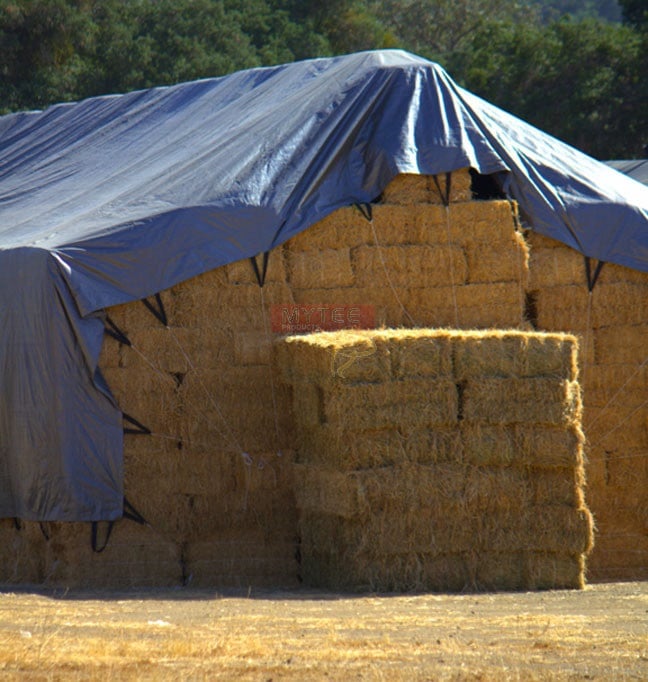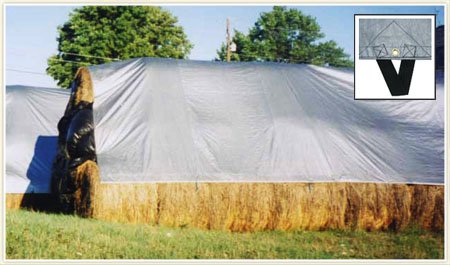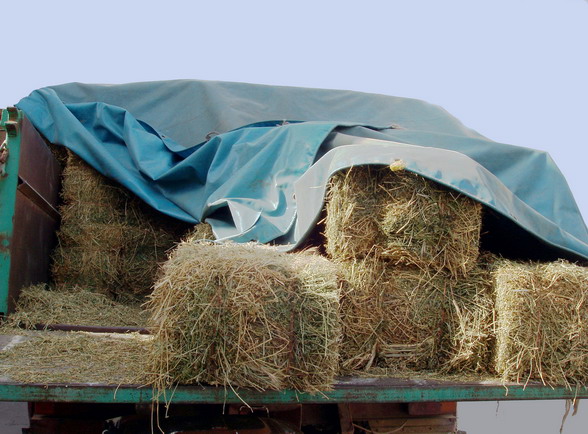The arrival of spring means that cattle farmers across the US will be making plans for spring, summer and fall grazing. Properly managing grazing lands and hay storage, especially during the summer months, is an important part of the farmer’s preparations for the coming winter. According to the University of Tennessee’s Gary Bates, storing hay under tarps is one of two strategies farmers can use to reduce their wintertime hay needs as much as 50%.
The primary purpose of hay tarps is to protect stored product from moisture. As any farmer knows, excessive moisture trapped inside hay causes two problems. First, it provides a breeding ground for bacteria, mold and fungus that can make the hay unusable as feed. An entire crop can be lost very quickly if it is not covered properly.
The second reason, although not as common as bacteria and mold growth, is the real potential of spontaneous fire. Moisture trapped within a stack of hay encourages activity among bacteria, an activity that generates heat as the bacteria multiply and grow. Heat can build up until the stack eventually catches fire.

Preventing Hay Rot
In a recent interview with the Leaf Chronicle, Bates said that the combination of hay tarps and stockpiling tall fescue in the fall could reduce the farmer’s hay needs by 30%-50%. The fescue is used to extend the fall grazing season so that less hay is used throughout the winter while using hay tarps reduces waste by protecting against rot. Given the fact that feeding cattle hay during the winter is a costly proposition, anything farmers can do to reduce the amount of hay they need ultimately helps the bottom line.
For hay tarps to fulfill their purpose, a farmer needs to make sure that any surface potentially exposed to rain is covered. There are multiple ways to accomplish this. Some farmers completely wrap their haystacks, covering the top and all four sides and staking the tarp to the ground. Others use a series of hay tarps suspended over ropes or an aluminum frame to create an easy-to-access hay house. Still others might stack hay up next to a barn, on the leeward side, and then cover only the top of the stack. At the end of the day, the hay bales or stacks need to be properly covered.
Spend More for Quality
Just as a trucker needs quality tarps that will last a long time, farmers should think twice about spending as little as possible on the cheapest tarps available. It is better to spend a little more for a quality product that will be durable for years over a cheaper product that might just make it through a season. Even the most expensive tarp will pay for itself in a season or two if a farmer is capable of reducing his/her hay waste by 30% to 50%.
A good quality hay tarp is a UV-treated piece of polyethylene fabric with heavy-duty threading and webbing every 4 inches or so. Reinforced brass grommets provide for easy tie-down with 16-inch spiral anchor pins. Double stitched seams and reinforcements around webbing make for a tarp that can withstand tough weather conditions.
As for color, today’s tarps are usually silver on one side and black on the other. The silver side is placed up to reflect sunlight while the black under surface underneath absorbs heat. This provides maximum protection on those hot, sunny days that could potentially rob hay of all its moisture. Hay with no moisture is no better than hay with too much.
Spring is here, and cattle farmers are making plans for summer and fall. Those plans should include hay tarps along with strategic planning of fall fescue. Combining the two could save the farmer substantially during next winter’s hay feeding season.
Sources:









